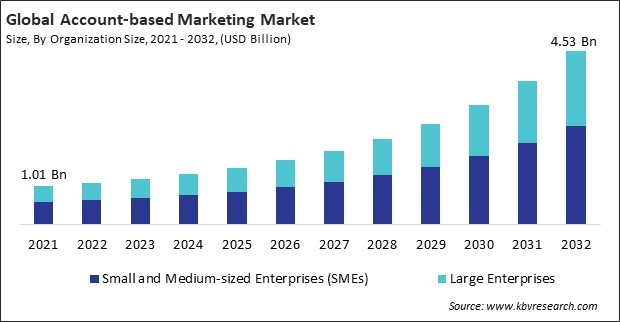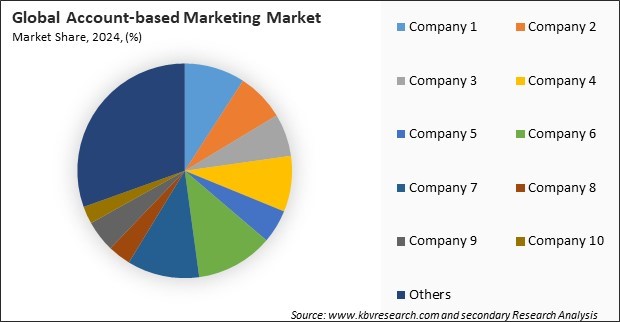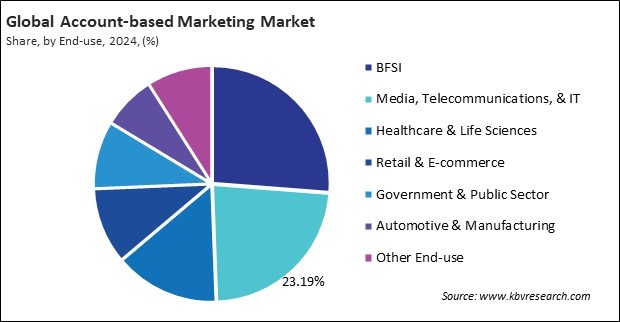“Global Account-based Marketing Market to reach a market value of USD 4.53 Billion by 2032 growing at a CAGR of 17.3%”
The Global Account-based Marketing Market size is expected to reach $4.53 billion by 2032, rising at a market growth of 17.3% CAGR during the forecast period.
The North America segment recorded 38% revenue share in the market in 2024. The region's dominance is driven by the high adoption of advanced marketing technologies, strong presence of key market players, and increasing demand for personalized B2B marketing strategies. Enterprises in the United States and Canada are leveraging AI, big data analytics, and machine learning to enhance their ABM efforts, ensuring better targeting and engagement of high-value clients.

The shift from traditional mass marketing to highly personalized and targeted engagement has become a key driver for the growth of the market. Businesses today recognize that generic marketing approaches fail to resonate with high-value clients, leading to wasted resources and lower conversion rates. ABM offers a solution by enabling companies to tailor their marketing efforts to specific accounts, ensuring that every message, campaign, and touchpoint is relevant to the prospect’s needs and pain points. In conclusion, the rising demand for personalized marketing strategies to enhance customer engagement drives the market's growth.
Additionally, In today’s competitive landscape, businesses recognize that customer retention is just as critical—if not more—than customer acquisition. Acquiring new customers is significantly more expensive than retaining existing ones, leading organizations to prioritize strategies that maximize customer lifetime value (CLV). ABM plays a crucial role by fostering deeper, long-term relationships with key accounts rather than focusing on high-volume, short-term sales. Thus, growing emphasis on customer retention and lifetime value maximization propels the market's growth.
However, One of the biggest challenges hindering ABM adoption, particularly for SMEs, is the high cost of implementation. Unlike traditional marketing strategies that allow businesses to reach a broad audience with minimal investment, ABM requires advanced technologies, specialized personnel, and a dedicated budget for personalized engagement. Implementing ABM involves investing in AI-powered analytics, marketing automation tools, CRM software, and content personalization platforms, all requiring substantial financial resources. In conclusion, high implementation costs and budget constraints for small and medium enterprises (SMEs) impede the market's growth.

The leading players in the market are competing with diverse innovative offerings to remain competitive in the market. The above illustration shows the percentage of revenue shared by some of the leading companies in the market. The leading players of the market are adopting various strategies in order to cater demand coming from the different industries. The key developmental strategies in the market are Acquisitions, and Partnerships & Collaborations.
On the basis of organization size, the market is classified into small and medium enterprises (SMEs) and large enterprises. The large enterprises segment acquired 41% revenue share in the market in 2024. Large enterprises, particularly in industries such as IT & telecom, BFSI, and healthcare, are heavily investing in strategic ABM to enhance customer retention, drive high-value deals, and strengthen relationships with key accounts.
By end-use, the market is divided into media, telecommunications, & IT, BFSI, healthcare & life sciences, retail & e-commerce, automotive and manufacturing, government & public sector, and others. The media, telecommunications, and IT segment garnered 23% revenue share in the market in 2024. Businesses in these industries rely on ABM strategies to target enterprise clients, improve customer engagement, and enhance digital transformation initiatives. The widespread adoption of cloud computing, 5G, and software-as-a-service (SaaS) platforms has increased the need for personalized marketing campaigns to attract high-value customers and drive B2B sales.

Based on account type, the market is characterized into strategic account-based marketing, account-based marketing lite, and programmatic account-based marketing. The account-based marketing lite segment attained 24% revenue share in the market in 2024. This segment is designed for businesses looking to target a broader set of accounts with a slightly less customized approach compared to strategic ABM. It combines elements of personalization with scalable outreach strategies, making it a popular choice among mid-sized enterprises.
Free Valuable Insights: Global Account-based Marketing Market size to reach USD 4.53 Billion by 2032
Region-wise, the market is analyzed across North America, Europe, Asia Pacific, and LAMEA. The Asia Pacific segment witnessed 26% revenue share in the market in 2024. The rapid expansion of digital marketing, rising number of SMEs, and growing penetration of AI-driven marketing automation tools have contributed to the increasing adoption of ABM in the region. Countries such as China, India, Japan, and South Korea are experiencing a surge in B2B digital marketing investments, with businesses focusing on targeted account-based strategies to improve lead conversion rates and client retention.
| Report Attribute | Details |
|---|---|
| Market size value in 2024 | USD 1.32 Billion |
| Market size forecast in 2032 | USD 4.53 Billion |
| Base Year | 2024 |
| Historical Period | 2021 to 2023 |
| Forecast Period | 2025 to 2032 |
| Revenue Growth Rate | CAGR of 17.3% from 2025 to 2032 |
| Number of Pages | 271 |
| Number of Tables | 380 |
| Report coverage | Market Trends, Revenue Estimation and Forecast, Segmentation Analysis, Regional and Country Breakdown, Market Share Analysis, Porter’s 5 Forces Analysis, Company Profiling, Companies Strategic Developments, SWOT Analysis, Winning Imperatives |
| Segments covered | Organization Size, Account Type, End-use, Region |
| Country scope |
|
| Companies Included | Adobe, Inc., Demandbase, Inc., HubSpot, Inc., Oracle Corporation, SAP SE, Salesforce, Inc., 6sense, Headley Media Ltd., Terminus Software, Inc., and Fypion |
By Organization Size
By Account Type
By End-use
By Geography
Our team of dedicated experts can provide you with attractive expansion opportunities for your business.

 Drivers
Drivers
 Restraints
Restraints
 Opportunities
Opportunities
 Challenges
Challenges
